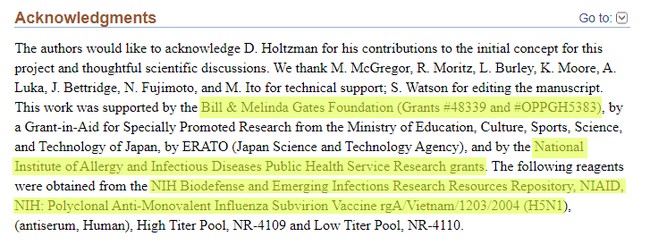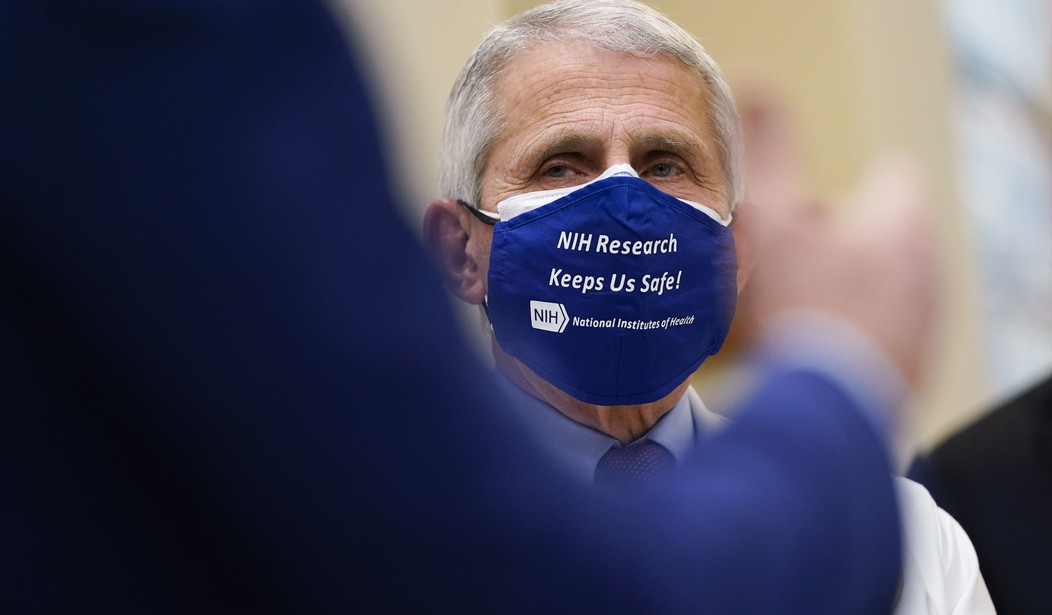(This is the first in a multi-part series. Part 2 can be read here, and Part 3 can be read here.)
IN THIS ARTICLE:
- NIH funded gain-of-function research as early as 2006.
- In 2011, NIH acknowledged the risks of GOF research but proceeded anyway.
- The Bill & Melinda Gates Foundation also contributed to GOF research outside the United States.
- Fauci and NIH Director Francis Collins published an op-ed in WaPo in Dec 2011 claiming the benefits of GOF research outweighed the risk of a pandemic.
- In 2011 NIH-funded researchers altered the H5N1 (bird flu) virus so it could infect ferrets, proving they could alter a virus to infect mammals that wouldn’t have been receptive to the original virus.
- The export of bird flu research findings was considered so dangerous that they were banned by the Dutch government.
- Despite a US government moratorium on GOF, Fauci ordered it to continue through Dr. Ralph Baric at UNC.
Among the things I didn’t have planned for May 2021: Becoming thoroughly immersed in the details of the SARS-CoV-2 virus and the COVID-19 pandemic. While I always had my educated opinion about the origins of the SARS-CoV-2 virus, I always knew that those opinions would be discounted by the MSM, metered by Big Tech, and ignored by the rest of the Branch Covidian Left. I also figured that with their united effort, any information that could prove or confirm any theories about the origins of the virus that turned the entire world upside-down would be buried and destroyed. And for the better part of the last year, I was right. Any discussion about investigating the origins of the SARS-CoV-2 virus was met with condemnation and labeled as some Trumpian conspiracy theory.
Yet, when Dr. Anthony Fauci appeared before a Senate Committee on May 11, Senator Rand Paul questioned him about a type of research of which I had never heard: “Gain-of-Function.” After a quick web search, I was alarmed by what I found. Gain-of-function refers to the process by which scientists genetically modify viruses to make them deadlier and more transmissible, presumably with the goal of developing cures and vaccines for future viral outbreaks, but which can also be used to create biological weapons – and that the US government had been funding some of this research, even in foreign countries. Not only was this research being conducted, but Dr. Fauci was also a proponent of such research, and the potential existed that the National Institutes of Health (NIH) and the National Institute of Allergy and Infectious Diseases (NIAID) were funding this type of research in international labs, including the Wuhan Institute of Virology (WIV).
As part of my investigation, I found that the NIH and NIAID were funding gain-of-function type research as far back as 2006. What is even more interesting is another organization that contributed to funding this research: The Bill and Melinda Gates Foundation.

In 2011, the NIH acknowledged the risks associated with gain-of-function research (emphasis added):
“While the public health benefits of such research can be important, certain information obtained through such studies has the potential to be misused for harmful purposes. The National Science Advisory Board for Biosecurity (NSABB) — an independent expert committee that advises the Department of Health and Human Services (HHS) and other Federal departments and agencies on matters of biosecurity — completed a review of two unpublished manuscripts describing NIH-funded research on the transmissibility of H5N1. These manuscripts — which describe laboratory experiments that resulted in viruses with enhanced transmissibility in mammals – concluded that the H5N1 virus has greater potential than previously believed to gain a dangerous capacity to be transmitted among mammals, including perhaps humans, and describe some of the genetic changes that appear to correlate with this potential.”
This release did little to calm the worries of many, leading Dr. Fauci and the Director of the NIH, Dr. Francis Collins, to write an op-ed that was published in the Washington Post about 10 days later. In addition to offering their support for continued gain-of-function research, the doctors warned of the potential of accidental or intentional release (emphasis added):
“Along with support for this research comes a responsibility to ensure that the information is used for good. Safeguarding against the potential accidental release or deliberate misuse of laboratory pathogens is imperative. The engineered viruses developed in the ferret experiments are maintained in high-security laboratories. The scientists, journal editors and funding agencies involved are working together to ensure that access to specific information that could be used to create dangerous pathogens is limited to those with an established and legitimate need to know.”
As part of their quest for a universal flu vaccine, the NIH and NIAID began funding gain-of-function research on the H5N1 influenza virus at the University of Wisconsin, the University of Tokyo overseen by Dr. Yoshihiro Kawaoka, and Erasmus University in Rotterdam in the Netherlands overseen by Dr. Ron Fouchier. Kawaoka and Fouchier were able to genetically modify H5N1 to infect ferrets, essentially proving they could alter a virus to infect mammals that wouldn’t have been receptive to the original virus. Their research was what was referred to during the NIH’s initial acknowledgment of the dangers associated with what was referred to at the time as Dual Use Research of Concern (DURC).
As word of their research findings spread, numerous scientists and government officials began questioning the need for research that carries with it the risk of creating an unstoppable and deadly virus.
Kawaoka and Fouchier’s research caught the attention of the NSABB, leading to the US Government seeking restrictions and guidelines to DURC and gain-of-function research.
“NSABB acting chair Paul Keim explained that the group was swayed by new and confidential information about both the risks and the potential benefits of the studies and by the fact that the U.S. government is putting in place a new policy that will provide a much more comprehensive review of so-called dual use research of concern. It had also concluded that redacting critical information and making it available only to people with a legitimate interest in seeing it was, at least in the short run, unworkable.”
As a result of the raised concerns, Kawaoka and Fouchier entered into a voluntary moratorium on DURC and gain-of-function research. At the center of this story is again Dr. Fauci, as he defended the use of the research and suggested the government would be creating new guidelines:
“NIAID is the National Institutes of Health (NIH) agency that funded the two H5N1 transmission studies. Fauci has been involved in national and international deliberations and has been at the center of US policy debate and decisions on the issue.
He said though the NSABB eventually determined that both studies should be published in full, the issues and challenges of balancing the potential benefits of the research with risks to public health haven’t ended.
He said government officials and scientists have learned some critical lessons about the execution and oversight of DURC, which spurred the Mar 29 publication of guidelines for federal agencies to use to address DURC issues.
Fauci said the federal government is developing guidelines to help biosafety committees at research institutions evaluate DURC, which will appear soon in the Federal Register for public comments. “The US government certainly looks forward to the input it receives as part of this process,” he said.”
When pressed for answers regarding the moratorium and when and how it could be lifted, Fauci had the following to say (emphasis added):
“So I can’t tell you when it’s going to be voluntarily lifted, but we are working very hard right now to get a process in place where we could have some broad general criteria of the kinds of experiments that could be done,” he told reporters. Fauci added that the moratorium narrowly focuses on “gain of function” experiments that increase the transmissibility and/or pathogenesis of H5N1.
He said he will attend a Centers of Excellence and Influenza Research and Surveillance (CEIRS) meeting in New York in July where he will conduct detailed discussions with researchers, including Fouchier and others, about approaches that might be used to speed lifting of the moratorium.
Fouchier’s research was of such concern that the Dutch government issued a block on the export of his NIH-funded research out of concern for the risk associated with publishing what amounted to the instructions to build a bioweapon.
“The Dutch government has asserted that the studies, which describe how to make bird flu virus more contagious, fall under regulations that control the export of weapons technology.”
In April 2012, Dr. Fauci appeared before the Committee on Homeland Security and Government Affairs of the United States Senate to testify about the use of DURC/Gain-of-function research and balancing the risks and “concerns.” Fauci led by emphasizing his agency’s “efforts to develop a ‘universal’ influenza vaccine” that “would potentially save millions of lives and be of great global economic benefit” and their role as “the lead component of NIH for research on biodefense against terrorist attacks…and naturally occurring emerging and re-emerging infectious diseases including seasonal and pandemic influenza.” Fauci testified that:
“NIAID conducts and supports basic research on microbiology and immunology; applied research, including the development of medical countermeasures for the diagnosis, treatment, and prevention of emerging infectious diseases; and clinical research to evaluate experimental drugs and vaccines.
And later (emphasis added):
Because of NIAID’s lead Federal role in supporting and conducting biodefense and emerging infectious diseases research, it can be expected that NIAID has funded and will fund some measure of DURC within its research portfolio. If a particular research experiment is identified as DURC, that designation does not necessarily mean that such research should be prohibited or avoided or not widely published. To the contrary, we must balance carefully the benefit of the science to public health, the biosafety and biosecurity conditions under which the research is conducted, and the potential risk that the knowledge gained from such research may fall into the hands of individuals with ill intent.
Despite the concerns of scientists everywhere, Fauci instructed the studies he funded to press on – sometimes even despite a moratorium, something Sen. Tom Cotton (R-AR) has hammered him on.
Check back tomorrow for Part II, as we dive into COVID-19’s potential origins and how the US may have funded and provided research guidance on the creation of the SARS-CoV-2 virus.













Join the conversation as a VIP Member